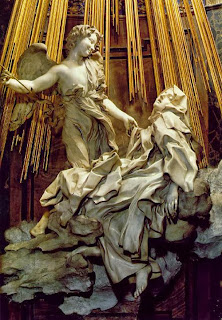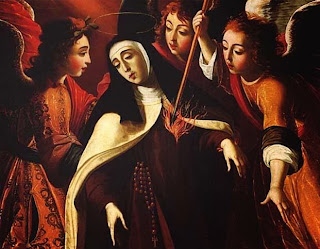What
parts of the writer’s experience does she assume to be universal? Which does
she view as unique to herself?
Most of Teresa experiences in her earlier stage of life are universal.
Like Teresa, most of us were guided to virtuous life by our parents, the Church
and the school authorities from our childhood, but like Teresa too, we tended
to get bad influences from world vanities and amusements right after we were
adolescence. We might return to spirituality and renew our relationship with
God when we are adult. However, trials and sorrows force us to fall into sin
again. And the process would be repeated again and again, mostly after the end
of our lives. In Teresa, although she experiences the rise and fall of spiritual
life, in a way, she has reached a special bound with God farther than most of
us. It is a rare grace from God that is unique in Teresa.
What
parts of the story do resonate with your own experience?
The rise and fall of the spiritual life; and the astonishment when
comparing my own sins and the graces God had granted me over my life. How He
has been greatly patient in my early stage of life, during which I ignored Him,
though not completely. How He has, ever since, called me over and again; waited
for me to come back to Him; and embraced me when I finally returned.
If
the writer is laying down a pattern for others to follow, do you find this
pattern to be good?
Absolutely. Especially the four stages of prayer that Teresa taught us,
although it is very difficult to follow, it will lead us to good. She also
inspired us to never abandoning our prayers, although during hard times it
seems to be fruitless. Once we abandon prayers, it would be hard to climb again
to our previous stage. She (and God) convinced us that in these times, actually
God never abandons us, He just waits for embracing us again when He feels
right.
Find
the writer’s stated reason for putting down her life in writing.
Teresa was commanded by God to write her experiences, and I think she
tells this most of the time during the entire story.
How
has the autobiography been changed by the years that have passed since its
publication?
The main idea is still relevant (our relationship with God), but perhaps
the nature of the convents and monasteries has been changing since then (I don’t
know for sure). But even if it is changed, I think God still calls His chosen
people, and the course of their struggles against sin and the devils are still
exist.
What
or whom does the writer judge? If she criticizes herself, what basis does she
use for judgment?
Teresa criticized herself as ‘wicked’ or sinned woman who didn’t deserve
such favours from God. She compared herself with other learned and spiritual
men who, like her, have reached high stage in relation with God.
Who
is ultimately responsible for her successes, and failures: society, family,
God? Do you agree?
God was behind her successes, through his confessors and other people
who were connected with her. Her failures were influenced by the society (her
superiors, her colleagues, citizens, and her friends). The first three accused
Teresa of imagining her ecstasies and her rebellion in founding the new convent,
which often brought doubts to Teresa; while her friends (women) outside the
convent drew her from spiritual life into vanity.
Do
you reach a different conclusion from the writer about the pattern of her life?
No, I believe we all experience the same although in different stages.
What
expectation did you bring to the story?
I have heard several things about Teresa Avila and her meditation
prayer, but I was more curious to know what kind of woman she is in person, and
how an ordinary person can become a saint.
What
have you brought away from this story?
First, that saints are ordinary people who are chosen by God for certain
mission. They could endure the sorrows and trials, because God helps them,
guides them to accomplish the mission.
Second, that virtuous life must be fought. We are so weak and wicked,
that very often we think we are alright as long as we don’t do anything evil. But
in fact, not doing anything IS doing wrong. God always wait for us to come to
Him, but we have the free will to respond to His call or not. And when we
achieve higher level in spiritual life, don’t get satisfied too quickly, we
must diligently maintain it and stay away from sin, because the closer we are
to God, the more severe the devils would persecute and try us.
Do
you understand more about the experience of God, than you did before you began
to read? Or do you remain on the outside?
Yes, I understand much more than before, this story is so inspiring me.
~~~~~~~~






















